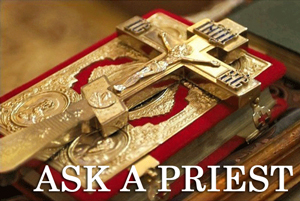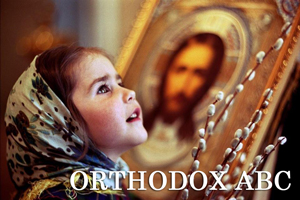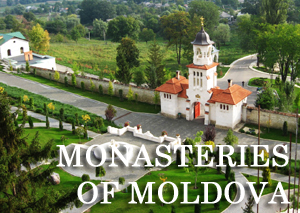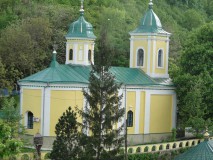
Monk Superior: Adrian (Baciu)
Contact data:
MD-5431, Saharna village, Rezinaraion
Republic of Moldova
Phone: +373 254 78 600
Mobile: +373 67178502
web: http://www.manastirea-saharna.md/
The monastery of Saharna is one of the oldest monastic settlements of the Orthodox Church of Moldova. There are three churches in the monastery: the Holy Trinity church, the cave church of Holy Annunciation, and the church of the Nativity of Theotokos.
Little is known about the founders and the time of foundation of the monastery. Even the scientists do not share a common opinion about the foundation time of this settlement. Its tumultuous and glorious history kindly and patiently waits to be revealed to the God-believing humanity and sang in glory.
The terrestrial monastery was founded in 1776 as a monastic metochion, by Schema-monk Bartholomew Ciungu (1739-1798). The name “Ciungu” wasn’t the monk’s last name, it actually was his informal name, meaning “with mutilated arm”. An inscription about elder Bartholomew was discovered in the Holy Trinity Monastery of Rudi, by architect Nicolae Tiganco. The plate under a portray that, unfortunately, was lost, was translated from Ukrainian in 1928. It says: “…in 1739, on day 23rd of month December, was the earthly birth of Vasily, born of priest Theodore and mother Pelageya. In 1760, on the day 2nd of month May, in the town of Savran, Podolia county, being engaged and going to his betrothed to wed with her, Vasily was unexpectedly wounded with a bullet in his arm, and in 1766… of month May he left his motherland and came to Moldova. In the year 1776, in the month of March, day 25th, entered Saharna. There was nothing there, it was a desolate place, and he built a church, cells, a yard, and other”.
Some facts allow us to make the supposition that before starting the construction of the new monastery, father Bartholomew, with a small community of monks, had lived in the cave monastery. However, life there was very hard, and father Bartholomew decided to build a terrestrial monastery, closer to the networks of communication and to the neighbouring settlements, but still in a place where the silent life of the monks would not be disturbed too much by earthly routine. It was quite difficult to find such a place, and it is said that monk Bartholomew followed an old Christian tradition, living in fast and prayer for 40 days, praying to All-Merciful Lord and to the saints to help him find the best place for the construction of the monastic settlement. According to the legend, he had a revelation on the 40th day. The Mother of the Lord, Virgin Mary appeared, in heavenly light, and pointed to the site where, by the will of the Heavenly Master, the monastery of the Holy Trinity was to be built. This place was in the valley on the foot of three hills. As a proof of this revelation, the Theotokos left a footprint on a rock. It can be seen today in the chapel built on the rock of Grimidon, where the revelation took place.
Father Bartholomew ended the construction in 1798. The monastery was then consecrated, and Hegumen Paisy was elected monk superior.
The chronicles relating to the property on which the village and the monastery were built go back to 1495. That year, on 24th January, Stephan the Great (Stefan cel Mare) approved an act dividing the property between the successors of Sima Rugina, mentioning, among others, the village of Saharna – as stated by historian Vladimir Nicu. The settlement is then mentioned again, in a possession act of 24th February 1602 issued by Prince Jeremiah Movila. In over one hundred years, on 23rd March 1733, the village of Saharna becomes property of landlord Constantin Hrisoverghi. The monastery built by monk Bartholomew becomes object of dispute with the successors of the landlord. In the year 1800 the court proclaims Smaranda, member of Hrisoverghi family, the proprietor of Saharna village, and an agreement is signed between the monastery’s monk superior and the landlord, confirmed in a letter signed on 24th November 1804. The letter says that the monastery enters under direct protection of the landlord of Saharna village, which saves the monastic settlement from eventual destruction in a conflict that arouse in 1842.
The construction of the monastery’s summer church started in 1818 and ended 1821, under the administration of Hegumen Tarasie. The church is consecrated in the name of Holy Trinity, supposedly by Metropolitan Veniamin COSTACHI. However, now chronicles were preserved, to confirm this.
In 1837, under the administration of Hegumen Onisifor, the church’s iconostasis was renovated. It is related that the iconostasis was a true work of art, containing precious icons that, unfortunately, disappeared when the monastery was closed by the godless soviet authorities in 1964.
In 1843 the monastery faced the risk of being dispossessed of highly precious icons and antiquity items. Some antiquarians from Ukrainian Podolie, profiting from simplicity of the monks, intended to buy for very low cost numerous priceless items. The situation was saved by financial agent Alexey Kliuceariov, who wrote a letter to the Governor of Basarabia Pavel Fyodorov. The Governor announced Archbishop Dimitrie Sulima, who took necessary action and prevented this robbery.
In 1857, with the care of monk superior Serafim, the cave monastery of Saharna was restored, for it had come to severe deterioration. This work required considerable financial resources, and the monastery obtained the permission of the diocesan authorities to cut and sell firewood from its estate.
One can get an idea about the financial situation of the monastery, considering, for example, the following facts: in 1894 the monastery leased its mill for a 6 years period, for 25 roubles per year (cost of a cow). The situation considerably improves in 1896, when monk superior Nicodim obtained permission of the Consistorium (diocesan authority) to open a stone quarry on the monastery’s estate. This activity brought over 8000 roubles to the settlement.
The improvement of the monastery’s financial situation allowed considerable renovation of the old cave monastery. The community consisted of 20 monks. On the territory of the monastery numerous household buildings, a mill, a guest house were built. A very rich library was developed, consisting of precious and rare church volumes.
In 1913 the monastery was visited by the Russian writer and publicist V. Rozanov, who was so much impressed by the settlement and by Basarabia, that he wrote several articles about his visit.
In 1918 the settlement changed its status, and the monastery became populated by nuns, conducted by nun superior Valentina. Some sources state that during that time the monastery had the name of “Queen Mary” in honour of Her Majesty, Queen Mary of Romania. Under the fruitful administration of nun superior Militina the community extended to 70 nuns.
By 1950s the monastery reached the peak of its flourishing, being one of the remarkable monastic settlements of our country. However, in 1964, the soviet regime closed the holy settlement, and transformed it into a psychiatry hospital. The icons were lost, many cult objects were destroyed, the cells were transformed into hospital wards, the summer church was used for a warehouse, while the winter church was transformed into a club. During that time a new building was edified on the territory of the monastery, which is nowadays used as the monastery’s refectory.
Nowadays
The monastery was reopened on 19th April 1991 with the blessing of His Eminence Metropolitan Vladimir (Cantarean). There were very few monks initially, who could hardly cope with the entire workload. Prayer services were celebrated twice a day, and between hours of collective prayer, the monks worked hard to raise the monastery from ruins.
The services were celebrated in the winter church, where side chapel of Reverend Macarios was built for winter daily services.
The summer church was restored between 1992 and 1998. Unfortunately, old painting was lost, and the new painting was created in realistic style by painter Vladimir Lazar from Rezina town.
The iconostasis was carved in wood brought from Romania, it contains icons of Reverend Saints Anthony and Theodosius of Kiev-Cave Monastery, Seraphim of Sarov, Siluan of Athos, Paisy Velichkovsky, Macarios of Egypt, Parascheva of Iassy, Ambrosy of Optina, Anthony the Great, Gherasim of Jordan, and other holy images. This diversity of nationalities of saints underlines the universal nature of the Church. Besides, at the entrance into the church naos, on its left side, the icon of Sant Stephan the Great is painted, reminding of the glorious past of our people and lands.
Holy Shrines
The monastery preserves with holiness the relics of Saint Macarios (Tincu), a gifted confessor, protector of Orthodoxy and Hegumen of this monastic settlement.
Much revered is the monastery’s icon of Saint Matrona of Moscow, containing relics of numerous saints.
There are many icons from 18th and 19th centuries, of the Saviour and Holy Apostles at the Last Supper, Holy Theotokos, Sant Nicholas, Saint Archdeacon Stephan, Reverent Parascheva, Reverent Seraphim of Sarov.
Services
20 monks live currently at the monastery, 10 of them are monastic clergy. Church services are celebrated twice a day, in Romanian and Russian (church Slavonic) languages, and on big holidays, in Greek.
Abridged from http://www.manastirea-saharna.md/
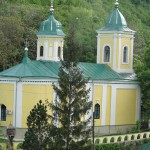
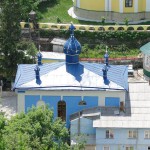
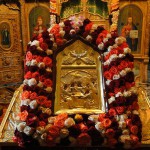
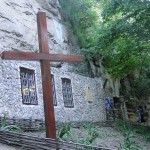
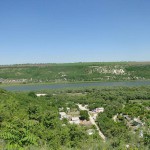
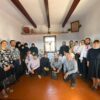 Memorial house of romanian elder Sofian Boghiu Consecrated in his native Village
Memorial house of romanian elder Sofian Boghiu Consecrated in his native Village 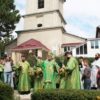 On the 14th Sunday after Pentecost, His Eminence Metropolitan Vladimir celebrated the Divine Liturgy in the St. Nicolas Monastery, Dobrusa village, Soldanesti region
On the 14th Sunday after Pentecost, His Eminence Metropolitan Vladimir celebrated the Divine Liturgy in the St. Nicolas Monastery, Dobrusa village, Soldanesti region 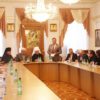 Inauguration of the volume of articles presented at the National Scientific Conference “The Orthodox Church and the State: Faith and Knowledge”
Inauguration of the volume of articles presented at the National Scientific Conference “The Orthodox Church and the State: Faith and Knowledge” 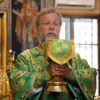 The 12th Sunday after Pentecost – kindness in God changes the world we live in
The 12th Sunday after Pentecost – kindness in God changes the world we live in 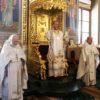 The 11th Sunday after Pentecost – loving our God and our neighbor
The 11th Sunday after Pentecost – loving our God and our neighbor 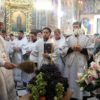 The Transfiguration of the Lord, celebrated in the Nativity of the Lord Cathedral in Chisinau
The Transfiguration of the Lord, celebrated in the Nativity of the Lord Cathedral in Chisinau 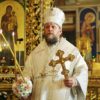 His Eminence Metropolitan Vladimir celebrates 65th anniversary
His Eminence Metropolitan Vladimir celebrates 65th anniversary  Divine Service at the St. Theodore of Tyre Monastery (Ciuflea) in Chisinau, and congratulation of Archimandrite Nicolae (Rosca), the Monastery’s confessor-administrator, on the 50th anniversary.
Divine Service at the St. Theodore of Tyre Monastery (Ciuflea) in Chisinau, and congratulation of Archimandrite Nicolae (Rosca), the Monastery’s confessor-administrator, on the 50th anniversary.  The Tenth Sunday after Pentecost: Divine Liturgy in the Nativity of the Lord Cathedral in Chisinau
The Tenth Sunday after Pentecost: Divine Liturgy in the Nativity of the Lord Cathedral in Chisinau 